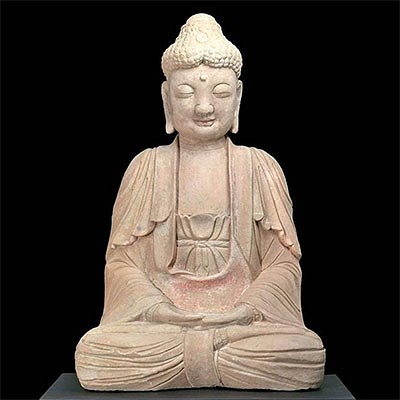10th C. Cambodian Khmer Angkor Stone Buddha Head
Lot 85c
About Seller
Artemis Fine Arts
686 S Taylor Ave, Ste 106
Louisville, CO 80027
United States
Selling antiquities, ancient and ethnographic art online since 1993, Artemis Gallery specializes in Classical Antiquities (Egyptian, Greek, Roman, Near Eastern), Asian, Pre-Columbian, African / Tribal / Oceanographic art. Our extensive inventory includes pottery, stone, metal, wood, glass and textil...Read more
Categories
Estimate:
$1,600 - $2,400
Absentee vs Live bid
Two ways to bid:
- Leave a max absentee bid and the platform will bid on your behalf up to your maximum bid during the live auction.
- Bid live during the auction and your bids will be submitted real-time to the auctioneer.
Bid Increments
| Price | Bid Increment |
|---|---|
| $0 | $25 |
| $300 | $50 |
| $1,000 | $100 |
| $2,000 | $250 |
| $5,000 | $500 |
| $10,000 | $1,000 |
| $20,000 | $2,500 |
| $50,000 | $5,000 |
| $100,000 | $10,000 |
| $200,000 | $20,000 |
About Auction
By Artemis Fine Arts
Feb 18, 2021
Set Reminder
2021-02-18 10:00:00
2021-02-18 10:00:00
America/New_York
Bidsquare
Bidsquare : Exceptional Antiquities, Asian, Ethnographic
https://www.bidsquare.com/auctions/artemis-gallery/exceptional-antiquities-asian-ethnographic-6373
Museum-worthy examples of Egyptian, Greek, Roman, Etruscan, Near Eastern, Far East / Asian, Pre-Columbian, African / Tribal, Oceanic, Native American, Spanish Colonial, Russian, Fossils, Ancient Jewelry, Fine Art, so much more! Artemis Fine Arts info@artemisfinearts.com
Museum-worthy examples of Egyptian, Greek, Roman, Etruscan, Near Eastern, Far East / Asian, Pre-Columbian, African / Tribal, Oceanic, Native American, Spanish Colonial, Russian, Fossils, Ancient Jewelry, Fine Art, so much more! Artemis Fine Arts info@artemisfinearts.com
- Lot Description
Southeast Asia, Cambodia, Khmer Empire (Angkor culture), ca. 10th to 12th century CE. A beautiful and naturalistic carved-stone Buddha head in Khmer style displaying a serene visage of petite closed eyes, a round nose, and a thick-lipped mouth curved in a gentle smile. Enveloped in a rich hue of taupe, the peaceful visage wears an elaborate crown topped by a detailed ushnisha, a symbol of his enlightenment, which is decorated with the relief of a Buddha sitting cross-legged under an arch at the front and a lotus flower representing purity of body, speech, and mind at the top. A pair of long-lobed ears flanks his calming countenance, representing his conscious rejection of the material world. A full head of straight hair sits above a diamond-shaped bhindi on his soft brow. Note the artist's careful attention to detail demonstrated via the intricate folds of his eyelids and wrinkles in his neck. Size: 4.25" W x 8.25" H (10.8 cm x 21 cm); 11.125" H (28.3 cm) on included custom stand.
Khmer art moved away from Indian styles in the 7th century CE to encompass its own framework; one example of this seen here is that this head is carved in the round, rather than as a relief on a stela, which was more prevalent among Indian and Javanese Hindu and Buddhist sculptures that were previously influencing Cambodian art. From this, we can infer that Khmer sculptors would have desired their artwork to be viewed from all sides, and thus placed in the center of temples rather than against a wall. While this artwork was religious - priests supervised its execution - its realism is unmistakable.
The head of Buddha is perhaps the most significant element of the deity, as it represents his immense body of knowledge and wisdom along with the tranquil nature that emanates from its expression. The prominent elongated ears are a physical feature symbolic of the Buddha's time as a prince when he wore elaborate ear ornaments to demonstrate wealth and prosperity. Of course, the prince stopped wearing them when he left the palace to become an ascetic; however, his earlobes remained stretched signifying a renunciation of the material world. Beyond the multi-layered meaning embodied in the iconography of this piece, the technique executed to create his intricate headdress is exemplative of the virtue of the artist.
Provenance: private Los Angeles, California, USA collection, acquired in 2010s; ex-Edgar Owens Galleries, Lake Hopatcong, New Jersey, USA
All items legal to buy/sell under U.S. Statute covering cultural patrimony Code 2600, CHAPTER 14, and are guaranteed to be as described or your money back.
A Certificate of Authenticity will accompany all winning bids.
We ship worldwide and handle all shipping in-house for your convenience.
#162058Fragment of a larger piece. Expected light surface wear commensurate with age. Otherwise, excellent with nice earthen deposits.Condition
- Shipping Info
-
All shipping is handled in-house for your convenience. Your invoice from Artemis Gallery will include shipping calculation instructions. If in doubt, please inquire BEFORE bidding for estimated shipping costs for individual items.
-
- Buyer's Premium



 EUR
EUR CAD
CAD AUD
AUD GBP
GBP MXN
MXN HKD
HKD CNY
CNY MYR
MYR SEK
SEK SGD
SGD CHF
CHF THB
THB














